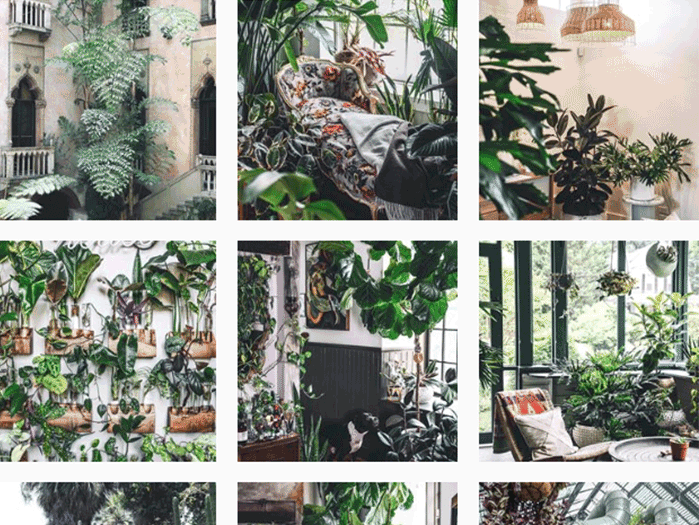Plant Parenthood
Yet again, it’s Instagram versus the things we love Hell is other people's plants | The Baffler
Hell is other people's plants | The Baffler o
l
u
m
n
s
In the year 2019, I finally found an apartment with a big window. I lived alone, with no pets. This was a perfect arrangement, one that allowed me to cultivate a lifelong desire: to live among a ridiculous number of houseplants.
As a child in rural North Carolina, I spent my time in the woods with a field guide. The soil of the Sandhills ecosystem prevented many of my mother’s gardening attempts, so my plant interest was pursued entirely in the wild. Even today, my escapist fantasies involve going back to school, becoming a botanist, and living the remainder of my life in a cabin in the North Carolina mountains.
My perspective on plants and plant rearing comes from this botanizing background, rather than a gardening one. Until I got into houseplants, my idea was that plants were best left in the wild, with our roles in their lives restricted to being good-hearted environmental stewards and reverent observers. Now, I have twenty-five houseplants, and despite some encounters with spider mites and clumsy repottings, they are all thriving. This isn’t because I followed a specific, top-secret recipe for plant success or because I have some kind of natural gift, a green thumb, if you will. It’s because I haven’t been consumed by the dreaded expectations of so-called “houseplant culture,” which are fueled almost wholly by Instagram. Numerous tags, such as #houseplantclub and #crazyplantlady, betray an endless parade of twee wall hangings, big lofts with giant fiddle leaf fig trees, and expensive West Elm furniture complemented by drooping monstera leaves.
Plants can’t be kept alive with the blanket statements on care sheets that read like IKEA assembly instructions.
Best-selling coffee table books like the wildly successful?Urban Jungleand Plant Style: How to Greenify Your Spacetell readers how to decorate with plants, painstakingly describing what color pot you should choose or how to style plants with furniture for optimum cuteness, while also offering obligatory one-size-fits-all directions for how to keep said plants alive, i.e. water every ten days, as if it’s that easy. Articles on decor and gardening websites come in basically a handful of bland flavors: listicles on the hottest plants to own right now; plant Instagram accounts to follow; trendy plants that we swear you can keep alive; and the truth about trendy houseplants,?which is that they are invariably hard to keep alive and that it’s all your fault. The result? Over a period of just three years, houseplant sales in the United States have surged almost 50 percent to $1.7 billion. Turns out those bespoke macramé hangers and fiddle-leaf figs are big business now, and a general rule of capitalism throughout history is: what’s good for business is usually bad for living things.
Houseplant culture is no different. Houseplant culture is bad for houseplants. Let’s begin with the most benign reason: houseplant culture creates unrealistic expectations for taking care of plants. Those snake plants and succulents are not, in fact, “impossible to kill.” If you want an unkillable plant, get one made of plastic. Just as Instagram makes us feel as if our lives, our bodies, and our friendships are inadequate, so too does it make us feel that we are bad plant parents because our plants aren’t in picture-perfect shape, pristinely arranged around a tasteful side table. Plants can’t be kept alive with the blanket statements that read like IKEA assembly instructions. If I watered my snake plants “every ten days,” as it says on the card, they would rot and die. Frankly the way some books and care cards talk about caring for plants amounts to criminal negligence, and when things don’t go according to plan, and your plant begins its death cycle, the response of these blogs is to blame you for following their directions, calling it overwatering or under-watering or under-fertilizing or over-fertilizing or whatever.
Plants, like animals, change over time in reaction to their environment—no plant is going to look forever as it did the first day you brought it home from the nursery, where it was subjected to only the most ideal conditions, and no plant is easy to care for. It is in your apartment now, an environment all its own, and when your apartment doesn’t have the most ideal lighting or humidity situation, the plant is bound to drop a few leaves as it rearranges its little plant resources to best suit its new life. In The New Plant Parent, perhaps one of the only good plant care books published in the last few years, author and devoted plant dad Darryl Cheng sums up these unrealistic expectations: “If you expect every plant to look ‘beautiful’ all the time and never drop a leaf, then every plant will seem hard to care for.”
This brings us to a broader issue I have with houseplant culture: plants are not furniture; they are living things. The concept of “decorating with plants” to me sounds about as stupid as “decorating with cats.” Plants, such as ferns, that need more intensive care than, say, “leaving them in the window and watering them once a month,” are frequently called “fickle” or “hard”— exhibiting the palpable disdain plant culture bloggers have for plants that don’t behave properly when faced with neglect. Keeping a plant alive is frequently seen as an inconvenience, an encumbrance in advance of a self-affirming Instagram post. At the same time, plenty of lip service is paid to theories about why millennials like houseplants, including the idea that they are somehow a way of coping with delayed parenthood. The answer is never simply because houseplants are fucking awesome. I don’t have plants because I long for children or a dog. I have plants because they are interesting, and I love them.
Plants, again, are very much alive, and they shouldbe treated with the same kind of respect and love as animals and children. When they don’t get what they need, they suffer and die. This is sometimes inevitable, and it is often sad. My mother used to tell me not to pick flowers because it hurts them. In a similar vein, don’t buy houseplants if you can’t devote to them the time, conditions, and care they need to live. We see plants as inanimate objects because they change and react to their environment on a much longer timescale than animals. We have the mistaken idea that plants do not respond to human love in the same way that animals do, that plants cannot feel in the traditional sense. No, a houseplant isn’t the same thing as a dog, but it is closer to a dog than it is to an image of a dog.
There’s no such thing as a green thumb, but there is such a thing as giving a shit or not giving a shit.
The true joy of houseplant ownership comes via observation and attention. It may take months for my snake plants to grow a new leaf, but every single night, a chemical reaction triggered in my calatheas, prayer plants, and oxalis causes them to fold their leaves and “go to sleep” as an animal would. My oxalis produces new sprouts every few days. My monstera unfurls a new, ever more complex leaf about once a week. If my calatheas and oxalis don’t get what they need, they fold up their leaves during the day, huddling up to conserve what limited resources they have left. My maidenhair ferns need daily misting, just like an animal needs to eat every day. The plants all have a humidifier that gets the house pretty steamy. I don’t like humid air, but I deal with it because it is what the plants need. I like to talk to my plants and run my hands across their leaves, pruning them, watering and aerating them, misting them, and repotting them. This caring isn’t an inconvenience of houseplants, it is the very reason for having them. When you care for your plants, they reward you by thriving and growing, which is, in some respects, the plants’ way of saying they love you back. There’s no such thing as a green thumb, but there is such a thing as giving a shit or not giving a shit.
The plant nursery industry pretty much only cares that you buy plants.? What happens after is none of their business. They don’t want to tell you the hard truths about plant parenthood. They don’t like to tell you that untold numbers of these houseplants are unethically sourced, threatening their continued existence, or, as Bloomberg reported, that growers send operatives into the jungle to find and take plants they think will be trendy, committing plant imperialism. They don’t like to tell you that you’ll need to keep greenhouse-like conditions in your house for tropical plants to thrive, or that many plants need daily care and sincere commitment. They don’t tell you that English ivy is a bad houseplant because if it ever gets outdoors it will become severely invasive, or that monstera (while rewarding) is a poorly behaved plant that will take over your house. These things run counter to the business of houseplant culture, which thrives on telling you to buy plants because they are pretty and easy, and then shames you for failure, even when you were just following their bad advice.
Furthermore, I’m done with books about which pots look good with African Violets or how to pair plants with vintage cameras. Tell me what these plants are, where they come from, why they look and behave the way they do. Why do calatheas have so many variations in their leaf patterns? Why do some plants fold up at night? How did these plants relate to other species in their native habitats? Who discovered them and classified them? How have they been used culturally?
It’s time we got rid of the expectation that plants are for looking at, for decorating instead of loving. If you want something that looks good and will sit politely in the corner of your room, I hear that pottery is easy to care for.




















